How to Cite | Publication History | PlumX Article Matrix
Manabendra Debnath2 and Biplab De*1
1Regional Institute of Pharmaceutical Science And Technology, Abhoynagar, Agartala, Tripura –799 006 India.
2Department of Human Physiology, M. B. B. College, College Tilla, Agartala, Tripura – 799 004 India.
ABSTRACT: It is well known fact that an intelligent can only survive in this world fulfilling all desirous. Women are the major contributors in the society, but their physiological features sometimes are not supporting to fulfill their demands. In this aspect development of I.Q is very essential. In this investigation I.Q is tried to be correlated with some of the physiological parameters of female students studying in class six in Agartala, State Tripura considering same height in cm and different group of castes. It has been found that physiological features were almost correlated to the I.Q in individual caste group and S.T. female students showed less average I.Q and then S.C., O.B.C. and general category showed highest average I.Q. From this study it can be suggested that socio – economical and educational assistance are still necessary towards the female students especially of ST, SC & OBC. It has been found that IQ of individual as equivalent to concrete intelligence also.
KEYWORDS: Height; Weight; Pulse- rate; Oral-temperature; IQ; Caste; Concrete intelligence
Download this article as:| Copy the following to cite this article: Debnath M, De B. A A Study on The Correlationship of Iq With Some Physiological Parameters of the Female Students Studying in Class Six in Agartala, Tripura, India and A Comparative Assessment With Concrete Intelligence. Biosci Biotechnol Res Asia 2008;5(1) |
| Copy the following to cite this URL: Debnath M, De B. A Study on The Correlationship of Iq With Some Physiological Parameters of the Female Students Studying in Class Six in Agartala, Tripura, India and A Comparative Assessment With Concrete Intelligence. Biosci Biotechnol Res Asia 2008;5(1). Available from: https://www.biotech-asia.org/?p=6921 |
Introduction
The term “Intelligence” is derived from a Latin word, framed by Cicero to translate a Greek word used by Aristotle to include all cognitive processes. This cognitive capacity was called intelligence and it was thought to be inherited, innate and general in nature. Again Science describes that “Intelligence” may be defined as an ultimate resultant of total brain functions and the nerve cells, the functional units of the brain, need life long access for accumulating experiences stored in memory, ready for immediate use; which deal with consciousness, analytical ability, memory, thoughts, knowledge and sleep-wake fullness; which are correlating with the mind or may define as part of the mind. The term intelligence is so commonly used, but it is so complex that it is difficult to give a comprehensive and precise definition of intelligence, which would be accepted by most. But, an intelligent person is always in an advantageous position in the society1.
Thus, in a nutshell, we can express intelligence as the capacity to understand the world, think rationally and use resources effectively when faced with challenges. But how this can be measured? To overcome this problem, after a great deal of thoughts, the I Q score recording came in effect to measure the label of intelligence of a person. I Q i.e. intelligence quotient score is a measure of intelligence that takes into account an individual’s mental and chronological ages2.
In this compilation, we are reporting the correlationship of I Q with some physiological parameters, if any, of the female students studying in class-VI in Agartala, State Tripura and a comparison was studied among different castes. Further, the concrete intelligence of individual was assessed and compared with IQ.
Material and Methods
Present investigation was carried out by conducting a survey among the female students of class –VI in different schools at Agartala irrespective to castes. Their I Q were measured by following Stanford – Binet test2 along with the physiological parameters such as height in cm, weight in kg, pulse rate / minute and oral temperature in 0F. Then we had chosen the data of the volunteers having same height 142 cm, as we have seen minimum 5 samples were available having 142 cm. height of volunteers in different caste groups – General, Schedule Caste, Schedule Tribe and Other Backward Caste. The I Q then tried to correlate with the different physiological parameters (Table 1) by the help of MS – Excel program of Microsoft – 1998 and the respective 4th order polynomial curve (Fig.12 Nos.) with R2 (correlation co- efficient square) and equation are reported here.
Table 1: Data for some physiological parameters and individual I Q & Concrete intelligence of female students studying in class – VI of different castes.
| Volunteer | Caste | Height | Weight | Pulse | Oral | I.Q. | Concrete | Average |
| No | (cm.) | (kg) | rate/min | temp(°F) | intelligence | I.Q. (C.I)±S.E.M | ||
| (C.I) | p<0.05 | |||||||
| 1.
|
Gen
“ |
142
142 |
30
31 |
112
82 |
98.3
98.5 |
125
95 |
30
28 |
118.6± 6.11 2.
(30.0 ± 0.63) |
| 3. | “ | 142 | 32 | 98 | 98.5 | 130 | 32 | |
| 4. | “ | 142 | 31 | 86 | 98.5 | 120 | 30 | |
| 5. | “ | 142 | 32 | 98 | 98.5 | 123 | 30 | |
| 6. | S.C. | 142 | 31 | 98 | 98.5 | 125 | 30 | 108.4 ± 6.87 |
| 7 | “ | 142 | 29 | 94 | 96.2 | 95 | 27 | (27.6 ± 0.81) |
| 8. | “ | 142 | 28 | 110 | 98.6 | 90 | 25 | |
| 9. | “ | 142 | 48 | 92 | 98.4 | 120 | 28 | |
| 10. | “ | 142 | 38 | 96 | 98.5 | 112 | 28 | |
| 11. | S.T. | 142 | 37 | 96 | 98.2 | 100 | 27 | 105.4 ± 7.24 |
| 12. | “ | 142 | 39 | 120 | 98.2 | 125 | 27 | (26.4 ± 0.39) |
| 13. | “ | 142 | 24 | 112 | 98.3 | 90 | 25 | |
| 14. | “ | 142 | 38 | 108 | 98.2 | 120 | 27 | |
| 15. | “ | 142 | 40 | 98 | 98.6 | 92 | 26 | |
| 16. | O.B.C | 142 | 39 | 100 | 98.3 | 120 | 30 | 111.8 ± 5.25 |
| 17. | “ | 142 | 34 | 110 | 98 | 100 | 27 | (28.8 ± 0.73) |
| 18. | “ | 142 | 34 | 96 | 98.2 | 98 | 27 | |
| 19. | “ | 142 | 35 | 103 | 98.2 | 121 | 30 | |
| 20. | “ | 142 | 38 | 105 | 98.3 | 120 | 30 |
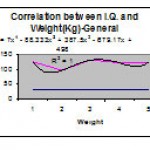 |
Figure 1
|
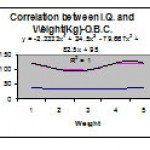 |
Figure 2
|
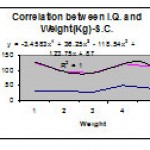 |
Figure 3
|
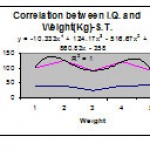 |
Figure 4
|
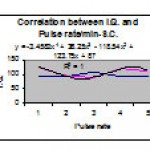 |
Figure 5
|
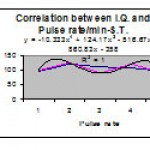 |
Figure 6
|
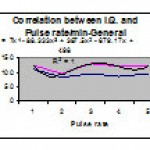 |
Figure 7
|
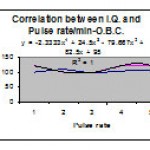 |
Figure 8
|
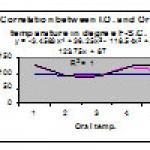 |
Figure 9
|
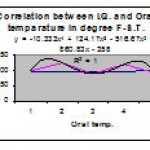 |
Figure 10
|
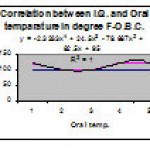 |
Figure 11
|
 |
Figure 12
|
To calculate an I Q score, the following formula is used, in which MA stands for mental age and CA for chronological age: I Q score = (MA / CA) x 100. Anyone who has a mental age equal to her chronological age will have an I Q equal to 100. Moreover people with a mental age that is greater than their chronological age will have I Qs that exceed 100; and those with a mental age lower than their chronological age will have I Qs lower than 1002. Terman’s categories in this aspect can be presented as – I Q range: 80 – 89 indicate dullness, 90 –109 indicate average intelligence, 110 – 119 indicate superior intelligence and 120 – 140 indicates very superior intelligence3. Stanford – Binet Test consists of a series of items that vary in nature according to the age of the person being tested. For example, young children are asked to copy figures or answer questions about everyday activities. Older people are asked to solve analogies, explain proverbs, and describe similarities that underline set of words.
The test is conducted orally. An examiner begins by finding a mental age level is at which the person is able to answer all questions correctly, and then moves on to successively difficult problems. When a mental age level is reached at which no items can be answered, the test is over. By examining the pattern of correct and incorrect responses, the examiner is able to compute an I Q score for the being tested2.
After the rapport has been established between the examinee and the examiner, the examiner to know concrete intelligence shall present the problem on a tray in front of the subject. If in case, the subject fails to continue the whole procedure of solving the given problem twice then the total process should be put to an end. Of course the examiner might guide the subject initially once if he/she has certain problem in continuing the process4.
Results and Discussion
Considering height in cm, as one of the physiological parameter, as a constant (142 cm), the I Q of volunteers were checked and found that same physiological features cannot claim same I Q. Of course in some of the cases I Q was showing same, as height was same. But it cannot be the rigid one, as because some other physiological and biochemical aspects are also involved. In this regard, it can be noted down such as for describing memory that memories are nothing but certain permanent electro – chemical changes, occurring in the individual brain and are also directly proportional to the number of amino acid molecules attached or detached.5 Interestingly no volunteers showed their I Q score under the range of dullness. The average I Q for S. C. and S. T. category were indicating the range of average intelligence. The O. B. C. volunteers were showing I Q score average in the beginning of the range of superior intelligence and for the case of general it was in the extreme top of the range of superior intelligence. Ultimately it has been found that general female volunteers were showing highest range of I Q., then O. B. C., S. C. and S. T. at below range. In this regard genetic factor can be considered. Then also food habit, tension i.e. environmental- social factors, disease conditions etc. are also involved. Thus the parameters weight in kg, pulse rate / min, oral temperature (°F) were taken in account respectively to correlate with I. Q. It has been found that this parameters are showing significant correlation with I. Q. in 4th order polynomial curve drawn by using the program MS – Excel of Microsoft 1998, as the R2 value of individual curve (R2=1) was evident. The concrete intelligence of individual was found equivalent, as it had appeared in the case of IQ.
From these above discussion one can suggest that socio – economical and educational support towards the female students for their I. Q. development is essential particularly to the S. C., S. T. and O. B. C. students to make them at par irrespective to different caste.
References
- De B., Dey M. and Choudhury R., J. Interacademicia, 8(2): 305 (2004).
- Feldman R. S., Understanding psychology, Tata McGraw – Hill publishing Company Ltd., New Delhi, 290 (2000).
- Freeman F. S., Theory and practice of psychological testing, Oxford IBH publishing Co., New Delhi, 132 (1965).
- Sengupta P and Sengupta G, Ucchamadhyamik Mano Bijnan (a book of Bengali version), Banerjee Publishers, Calcutta, 165 (1985).
- Majumder B. G., Indian Educational Review, 32 (1), 81 (1997).

This work is licensed under a Creative Commons Attribution 4.0 International License.





